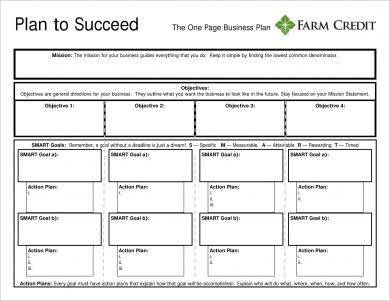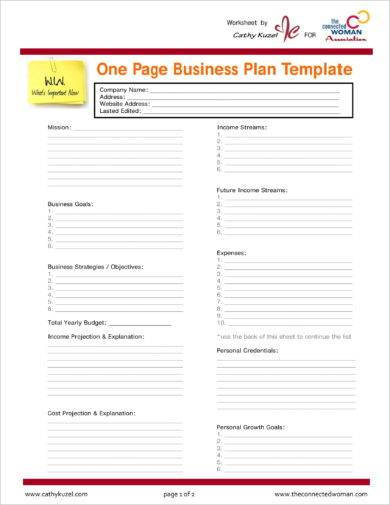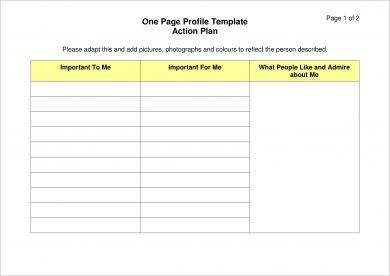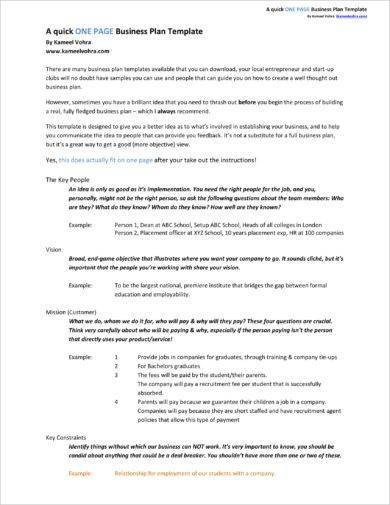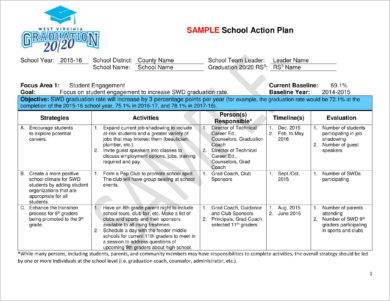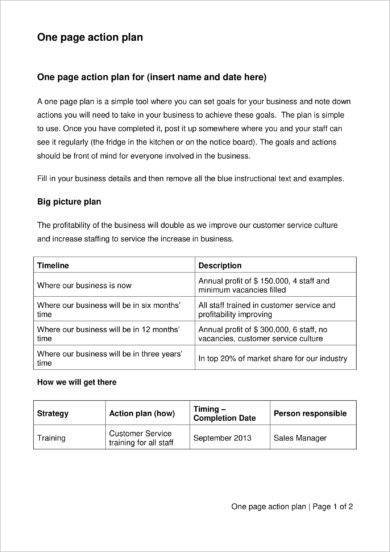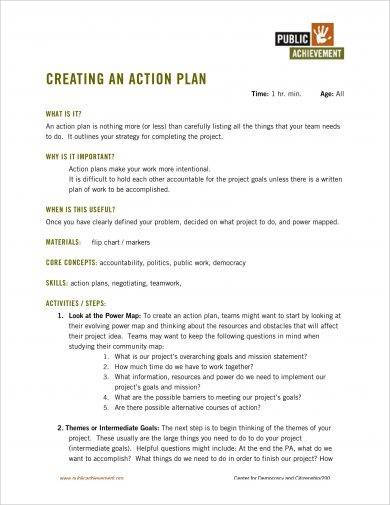11+ One-Page Action Plan Examples to Download
Creating an action plan provides a lot of benefits to an organization especially for businesses. As we are living in a world where time is always of constraint, an action plan is needed to maximize the time in order to achieve a planned goal.
One Page Action Plan Example
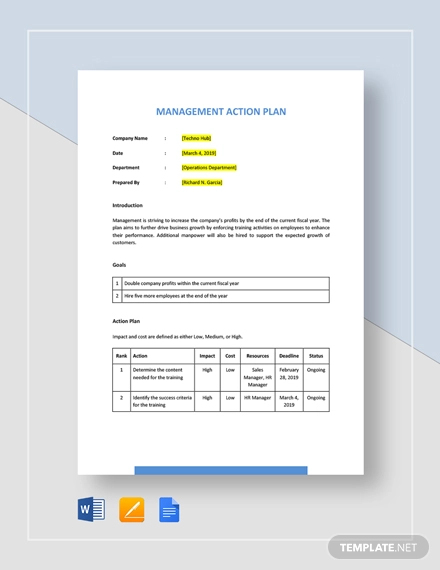
One Page Strategic Action Plan Example
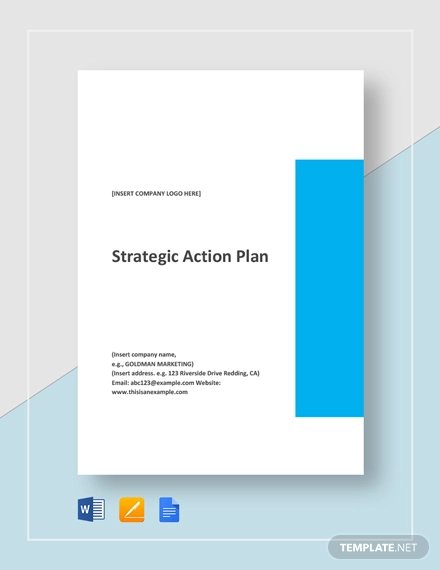
Furthermore, with general action plan, the activities of the individuals involved in the execution of the plan can be monitored and sidetracking would be prevented. Moreover, it clearly plots the amount of time you must spend on a certain task, and everyone will have an assignment in a certain task, thus encouraging teamwork and cooperation among the members. With proper sequence of steps in an action plan, the success of reaching the goal is very likely.
Below are one-page examples of action plan that might help you when you start to create your action plan. Check them out in the next section.
Concise One-Page Action Plan Example
Farm Credit One-Page Action Plan Example
One-Page Action Plan Template Example
Tips for the Creation of an Effective Action Plan
Establishing a goal is not enough when you want your entity or organization to be successful. Similarly, creating an action plan is not enough when there is no implementation. Implementation may be difficult if the pathway for implementation is not clearly identified and established in your action plan. Thus, outlining the specific step-by-step tasks is necessary in order to have a detailed guide toward achieving your goal.
In order to do so, here are some important tips that will help you in creating an effective action plan.
1. Build the Foundation
In starting an action plan, you and your team must have the necessary preparation and commitment to the project. You can start by determining not only the resources needed in order to implement the plan but also the obstacles that might affect the whole project. Once you understood and know what you want to achieve, it would become easier for you to determine the necessary steps to achieve the goal that you have planned.
In studying the resources and obstacles that might affect your project plan, the following are the guide questions that you may keep in mind:
- What are the dominating goals and missions in our plans?
- How much time do we need to work on the certain project?
- What resources do we need to secure or acquire for our project’s goals and mission?
- What might be the possible barriers that may hinder the goals of our project?
- Are there any possible alternative courses of action in case the first plan will not work?
2. Establish Intermediate Goals
The next step in your simple action plan is to establish the themes of your project. These pertains to the intermediate goals that you need to do for your project. The following questions may assist you in determining your intermediate goals:
- What do we want to accomplish at the end of a certain period?
- What large things do we need to do in order to finish our planned project?
- How will we measure our success? How do we know that we have achieved our goals?
This is the state and a perfect time to revisit or revise your project’s mission statement in order to clarify where you are heading and what actions you need to do in order to achieve those plans.
One-Page Business Action Plan Example
One-Page Profile Template Action Plan Example
One-Page Project Action Plan Example
Quick One-Page Action Plan Example
3. Prioritize Goals
Typically, a company has a lot of professional goals that they want to achieve in a certain point in time. They have a lot of goals that, sometimes, they do not know which must be completed first. You must not let this happen in your entity for if you do not know which goals must be prioritized, you might end up delaying the achievement of a certain goal, thus in turn delaying the growth of the entity.
Hence, you must know which goal is needed to be achieved first and which goals can be done later. In this way, you know where to focus your attention and resources and that is on the goal that you chose to be completed first. It is not easy to choose which one must be done first, and it really requires carefully judgement by the whole team. You may also see business action plan examples.
4. Brainstorm
The next thing that you must do is to take one of the project’s intermediate goals and brainstorm on what must be done to implement that goal. You must have a big list of all the possible strategies to achieve the goal.
The team must think as broadly as possible to get everything down. Write down every possible strategies that the team can think of and make sure that everything is relevant, leading only to the desired goal. Otherwise, your implementation will be derailed and your basic action plan will become ineffective.
5. Set Objectives
After carefully thinking on the large steps that you might implement toward achieving your goal, the next step is to get the team think of a more specific objective to reach the goal. It is common that there are a lot of ideas that your team members might come up with, but make sure that the objectives they listed are SMART. You may also like employee action plan examples.
When talking about objectives, we often see the word SMART attached to it. So what really are SMART objectives? The acronym SMART means specific, measurable, achievable, realistic, and time-bound. What does these mean?
- Specific. Your objective must be specific and it must address the matter specifically.
- Measurable. It must be measurable to determine whether or not it can be achieved and also to determine your progress.
- Achievable. It must also be achievable, within the means and capacity of your resources and the team.
- Realistic. It must be realistic, practical, and, most importantly, relevant and related to the goal that you want to achieve.
- Time-bound. It must have a target date to complete, and the time period for the completion must be clearly specified.
6. Determine the Sequence of Tasks
Now that you have clearly established your goals as well as the activities that you need to do in order to achieve your goals, you must then know and set your priorities.
Know which activities are most important and absolutely necessary to complete your project. Also determine which activities must be done first in order to fit the activities in your time budget. So as to be efficient in using your time, see to it that you are doing those tasks that are prerequisites of the other tasks, and simultaneously do other tasks that can be started without depending on other tasks. You may also check out work action plan examples.
You really need many heads in order to come up with the right sequence of the tasks that are needed to achieve your goals for it might be confusing which one must be done first especially if you have tons of tasks listed. You might be interested in strategic action plan examples.
In order to come up with a simplified sequence of those tasks, you might consider breaking up the team into small groups in which all groups must rank the different tasks according to their order of priority as they see fit.
After the different groups come up with their own sequence of priorities, they can come back together and compare their sequence with the other groups, discuss the differences between their general plans, and decide together which order is the best.
7. Create Timelines
After determining the tasks and their sequence, you must set a timeline for the tasks. The timeline must be realistic enough and it must consider all the possible normal delays.
A Gantt chart is one of the tools that can be extremely useful in plotting the timeline for a certain project as well as to plot its correct sequence. It is commonly utilized by most entities since the readers of such chart can immediately understand the sequence of the tasks through its organized presentation.
You can also easily determine the amount of time allowed for each task as well as which tasks represents the prerequisites for the other tasks and which tasks are dependent on the completion of a certain task.
8. Set Accountability
If you allow all the members in a team to choose which task they would want to be involved with, there might be some tasks where no one would want to be held accountable for. Thus, in order for everyone to participate in the implementation of the tasks needed to achieve the goal, proper division of tasks must be implemented, ensuring that everyone has their own responsibility. You may also see restaurant action plan examples.
Setting someone to be accountable for a certain task is important so you can monitor the progress of the completion of such tasks and so that you have someone to ask to in case of issues or problems. This is also a way to check on whether or not they are capable of doing the task. You may also like sales action plan examples.
9. Plan Celebrations
Creating and implementing an action plan might be stressful and exhausting along the way. Hence, it is fitting and proper that you will plan for the upcoming celebration after the completion of the task. This would also motivate the members to complete their different tasks accurately and on time. You may also check out research action plan examples.
Note that completing the task alone is a lot different from completing the task accurately and within the specified time. When you complete the task accurately, this means that you are doing it well without using too much resources but use only those that are intended for that specific task you are working on. This also means that you avoid material errors during the process as well as on your output. You might be interested in corrective action plan examples.
The task must also be completed on time, especially if there are other tasks dependent on that task. Otherwise, everything will be delayed, leading to a delayed completion of the task.
When everything is done carefully and smoothly according to the plans written down in an action plan, do not forget to reward your team with a celebration, acknowledging the efforts and performance of the whole team. You still have a lot of projects to work on in the future, so you must constantly motivate yourselves by giving timely rewards such as a small celebration for the small success you have achieved. You may also see budget action plan examples.
This might just be a small step and has a small impact to your entity, but when goals are slowly and constantly achieved, this can motivate other teams as well, which would ultimately result in the overall effectivity of the entity.
School One-Page Action Plan Example
Simple One-Page Action Plan Example
Standard One-Page Action Plan Example
Quick Recap
Creating a simple action plan is important because it helps the members of an organization or an entity plan their goals and determine the specific actions needed in order to achieve a certain goal. This would also help the team be guided in the small tasks that they are doing which all lead to the completion of a predetermined goal.
Presented above are the tips to create an effective action plan which are as follows: build the foundation, establish intermediate goals, prioritize goals, brainstorm, set objectives, determine the sequence of tasks create timelines, set accountability, and plan celebrations.
Adhering to the above tips can surely help you not only in the creation of an effective formal action plan but also in the implementation of such plans for a plan can never be considered effective when there is no proper implementation for such plan.
You may also refer to the above examples of one-page action plans for concise and brief action plans.




